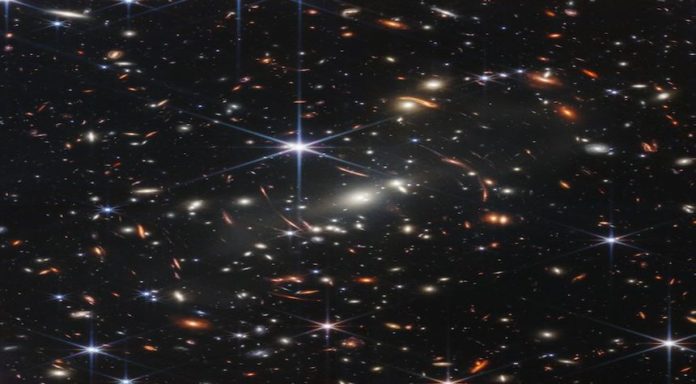NASA’s first image from its deep-field imaging camera gave mankind a glimpse back to the beginning of the universe with the $9.7 billion James Webb Space Telescope.
It took a while to create the image. NASA created the Next Generation Space Telescope (NGST), at a cost of half a million dollars in 1996. NASA changed the design of the telescope as a result of changing technology and a shaky Congress. The James Webb Space Telescope was renamed after the NASA administrator who oversaw the first days of the manned satellite program. It became the most complicated project NASA has ever undertaken.
The NGST launched flawlessly on Christmas Day 2021. It traveled over 900,000 km to a location where it could imagine the universe without any light from the sun, moon, or earth. The final product is truly amazing after several weeks of testing and calibrations.
It’s here–the deepest, sharpest infrared view of the universe to date: Webb’s First Deep Field.
Previewed by @POTUS on July 11, it shows galaxies once invisible to us. The full set of @NASAWebb‘s first full-color images & data will be revealed July 12: https://t.co/63zxpNDi4I pic.twitter.com/zAr7YoFZ8C
— NASA (@NASA) July 11, 2022
Numerous problems arose that went beyond the initial $500 million costs. In 2005 there was a major redesign, a tear in the sun shield from a practice deployment, recommendations by an independent review board, and a threat by Congress to cancel the project. There were also problems with the telescope itself.
The project was nearly canceled multiple times. JWST was described in a Nature article as “the telescope which ate astronomy.” This is a familiar story in Washington. You can spend so much money on a project that it becomes impossible to cancel it. Although the JWST’s promise was amazing, it cost NASA about one-quarter of its budget over a decade to get it on the ground.
There was also controversy about naming the telescope after James Webb. Webb was accused of being part of an effort by the U.S. State Department to exterminate gay people in the 1950s and 1960s. Webb was an Undersecretary of State during this period, and the woke lobby accused Webb of being part of the hysteria.
Closeted gays were very vulnerable to being blackmailed by foreign agents. More than 300 state department employees were fired after being caught up in the Red Scare. Webb has never been implicated in purges.
CNN:
This image is SMACS 0723. A large group of clusters of galaxies acts as a magnifying mirror for the objects behind them. This is gravitational lensing. It was Webb’s first deep-field view of faint, distant galaxies.
The White House hosted a preview event featuring NASA Administrator Bill Nelson, during which the presentation took place.
Nelson said that it was the “deepest image of the universe” ever taken.
NASA released the following information: “This piece of the vast universe covers an area approximately the same size as a grain of sand kept at arm’s reach by someone on the ground.”
The telescope gradually collected photons of sunlight over 12 hours. This allowed the image to be taken in a relatively short time span. The telescope will need to train its imaging technology for several days simultaneously in order to get images as far as NASA would like, 13 billion light-years away.
The space observatory was launched in December and will allow you to see inside the atmospheres of exoplanets. You can also view some of the first galaxies formed after the universe began.
Webb’s scientific capabilities are highlighted in the first image release. Webb’s massive golden mirror and science tools can produce stunning images.
Ten billion dollars was spent on JSWT, which is a lot for astronomy. NASA could have done so much more with this money. What else could the government do with that money? NASA is an amazing technological accomplishment, and the James Webb Space Telescope is a marvelous machine.
However, unlike many new technologies, there is no prospect of a financial return. We can’t predict this. All of the “basic research,” in the past, has paid off in some way. Perhaps it is enough to know that the James Webb Space Telescope, and the human hunger for knowledge it represents, allows us to get closer and more deeply understand some of the most intriguing mysteries of the universe.




